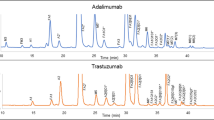Abstract
In this chapter, we describe an LC-fluorescence (FLR)/MS-based method for released N-glycan analysis in the development of biotherapeutic proteins. The method includes enzymatic release and labeling of N-glycans with a signal-enhancing tag, LC-MS data collection, and data interpretation. Using the given protocol, up to 24 glycan samples can be prepared within 1 h, while the LC-FLR/MS data can be collected and analyzed using an established data processing method in a semi-automated manner.
Access this chapter
Tax calculation will be finalised at checkout
Purchases are for personal use only
Similar content being viewed by others
References
Zhang L, Luo S, Zhang B (2016) Glycan analysis of therapeutic glycoproteins. MAbs 8(2):205–215. https://doi.org/10.1080/19420862.2015.1117719
Reusch D, Tejada ML (2015) Fc glycans of therapeutic antibodies as critical quality attributes. Glycobiology 25(12):1325–1334. https://doi.org/10.1093/glycob/cwv065
Pereira NA, Chan KF, Lin PC, Song Z (2018) The “less-is-more” in therapeutic antibodies: Afucosylated anti-cancer antibodies with enhanced antibody-dependent cellular cytotoxicity. MAbs 10(5):693–711. https://doi.org/10.1080/19420862.2018.1466767
Shields RL, Lai J, Keck R, O’Connell LY, Hong K, Meng YG, Weikert SH, Presta LG (2002) Lack of fucose on human IgG1 N-linked oligosaccharide improves binding to human Fcgamma RIII and antibody-dependent cellular toxicity. J Biol Chem 277(30):26733–26740. https://doi.org/10.1074/jbc.M202069200
Yu M, Brown D, Reed C, Chung S, Lutman J, Stefanich E, Wong A, Stephan JP, Bayer R (2012) Production, characterization, and pharmacokinetic properties of antibodies with N-linked mannose-5 glycans. MAbs 4(4):475–487. https://doi.org/10.4161/mabs.20737
Ruhaak LR, Zauner G, Huhn C, Bruggink C, Deelder AM, Wuhrer M (2010) Glycan labeling strategies and their use in identification and quantification. Anal Bioanal Chem 397(8):3457–3481. https://doi.org/10.1007/s00216-010-3532-z
Kozak RP, Tortosa CB, Fernandes DL, Spencer DI (2015) Comparison of procainamide and 2-aminobenzamide labeling for profiling and identification of glycans by liquid chromatography with fluorescence detection coupled to electrospray ionization-mass spectrometry. Anal Biochem 486:38–40. https://doi.org/10.1016/j.ab.2015.06.006
Lauber MA, Yu YQ, Brousmiche DW, Hua Z, Koza SM, Magnelli P, Guthrie E, Taron CH, Fountain KJ (2015) Rapid preparation of released N-Glycans for HILIC analysis using a labeling reagent that facilitates sensitive fluorescence and ESI-MS detection. Anal Chem 87(10):5401–5409. https://doi.org/10.1021/acs.analchem.5b00758
Haxo T, Jones A, Kimzey M, Dale E, Vlasenko S, Mast S (2016) Automated N-glycan sample preparation with an instant glycan labeling dye for mass spectrometry. Prozyme Application Note
Nagy G, Peng T, Pohl NLB (2017) Recent liquid chromatographic approaches and developments for the separation and purification of carbohydrates. Anal Methods 9(24):3579–3593. https://doi.org/10.1039/C7AY01094J
Melmer M, Stangler T, Schiefermeier M, Brunner W, Toll H, Rupprechter A, Lindner W, Premstaller A (2010) HILIC analysis of fluorescence-labeled N-glycans from recombinant biopharmaceuticals. Anal Bioanal Chem 398(2):905–914. https://doi.org/10.1007/s00216-010-3988-x
Campbell MP, Royle L, Radcliffe CM, Dwek RA, Rudd PM (2008) GlycoBase and autoGU: tools for HPLC-based glycan analysis. Bioinformatics 24(9):1214–1216. https://doi.org/10.1093/bioinformatics/btn090
Campbell MP, Royle L, Rudd PM (2015) GlycoBase and autoGU: resources for interpreting HPLC-glycan data. Methods Mol Biol 1273:17–28. https://doi.org/10.1007/978-1-4939-2343-4_2
Han L, Costello CE (2013) Mass spectrometry of glycans. Biochemistry (Mosc) 78(7):710–720. https://doi.org/10.1134/S0006297913070031
Tsai PL, Chen SF (2017) A brief review of bioinformatics tools for glycosylation analysis by mass spectrometry. Mass Spectrom (Tokyo) 6(Spec Iss):S0064. https://doi.org/10.5702/massspectrometry.S0064
Hilliard M, Alley WR Jr, McManus CA, Yu YQ, Hallinan S, Gebler J, Rudd PM (2017) Glycan characterization of the NIST RM monoclonal antibody using a total analytical solution: from sample preparation to data analysis. MAbs 9(8):1349–1359. https://doi.org/10.1080/19420862.2017.1377381
Bunz SC, Rapp E, Neususs C (2013) Capillary electrophoresis/mass spectrometry of APTS-labeled glycans for the identification of unknown glycan species in capillary electrophoresis/laser-induced fluorescence systems. Anal Chem 85(21):10218–10224. https://doi.org/10.1021/ac401930j
Zhang X, Birdsall R, Yu YQ (2019) Increasing productivity and confidence of N-lilked glycan analysis of biosimilars using the BioAccord system. Waters Application Note
GlycoWorks RapiFluor-MS N-Glycan Kit—Automation (2017) Waters Application Note
Best Practice in the Analysis of RapiFluor-MS labeled glycans using ACQUITY QDa Detector (2016) Waters White paper
Author information
Authors and Affiliations
Corresponding author
Editor information
Editors and Affiliations
Rights and permissions
Copyright information
© 2021 Springer Science+Business Media, LLC, part of Springer Nature
About this protocol
Cite this protocol
Zhang, X. (2021). Released N-Glycan Analysis for Biotherapeutic Development Using Liquid Chromatography and Mass Spectrometry. In: Posch, A. (eds) Proteomic Profiling. Methods in Molecular Biology, vol 2261. Humana, New York, NY. https://doi.org/10.1007/978-1-0716-1186-9_4
Download citation
DOI: https://doi.org/10.1007/978-1-0716-1186-9_4
Published:
Publisher Name: Humana, New York, NY
Print ISBN: 978-1-0716-1185-2
Online ISBN: 978-1-0716-1186-9
eBook Packages: Springer Protocols



